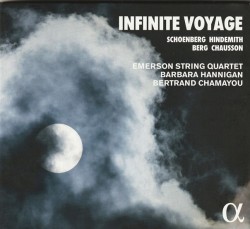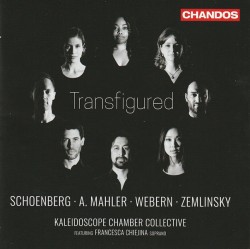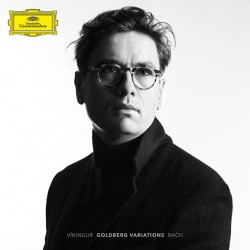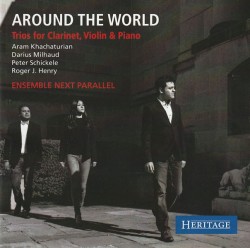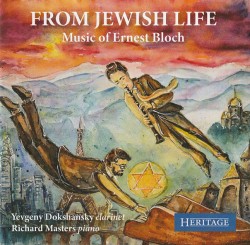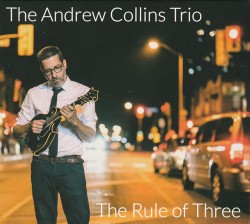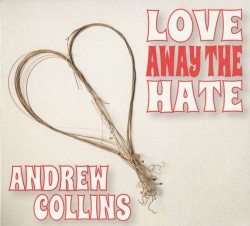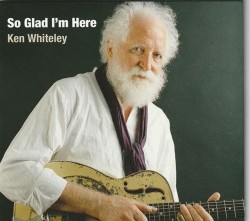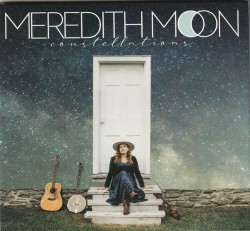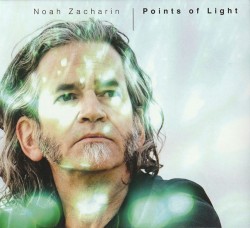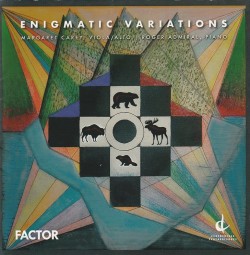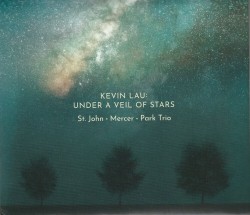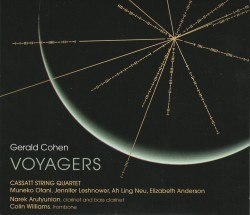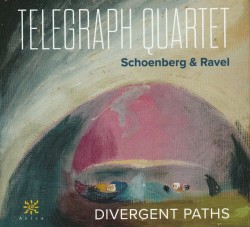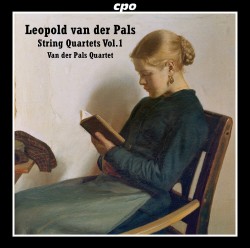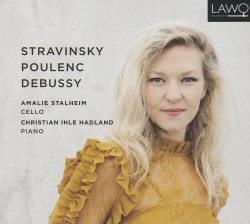Editor's Corner - February 2024
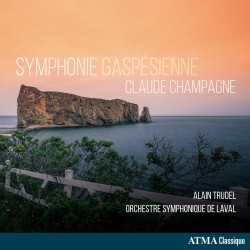 As I write this in the early days of January it is fitting that I speak about my New Year’s resolution to be a better friend to my cello this year. With this in mind I’m getting together with my friends Anne (violin) and Adam (piano) for trio sessions after a lengthy hiatus. Having previously played music by Mendelssohn and Mozart, this year we have embarked upon Beethoven’s Piano Trio Op.1, No.2. It’s a piece that I worked on extensively some 20 years ago and have been inspired to revisit by a new release, Beethoven Complete Piano Trios performed by the Weiss Kaplan Stumpf Trio (Bridge Records 9505A/C bridgerecords.com). Yael Weiss (piano), Mark Kaplan (violin) and Peter Stumpf (cello) all have notable solo careers and have been playing together as a trio for more than two decades. What I particularly like about this 3CD package – in addition to the fabulous performances – is that in lieu of program notes for the familiar trios, the booklet includes essays by each of the three performers about their own connections to the music. In the case of Weiss, this involves a lineage of teachers reaching all the way back to Beethoven via her mentor Leon Fleisher, a student of Schnabel, who worked with Leschetizky, a student of Liszt, who studied with Czerny, a student of the great master himself. Kaplan and Stumpf each share their personal takes on the trios, and the occasion of the recording.
As I write this in the early days of January it is fitting that I speak about my New Year’s resolution to be a better friend to my cello this year. With this in mind I’m getting together with my friends Anne (violin) and Adam (piano) for trio sessions after a lengthy hiatus. Having previously played music by Mendelssohn and Mozart, this year we have embarked upon Beethoven’s Piano Trio Op.1, No.2. It’s a piece that I worked on extensively some 20 years ago and have been inspired to revisit by a new release, Beethoven Complete Piano Trios performed by the Weiss Kaplan Stumpf Trio (Bridge Records 9505A/C bridgerecords.com). Yael Weiss (piano), Mark Kaplan (violin) and Peter Stumpf (cello) all have notable solo careers and have been playing together as a trio for more than two decades. What I particularly like about this 3CD package – in addition to the fabulous performances – is that in lieu of program notes for the familiar trios, the booklet includes essays by each of the three performers about their own connections to the music. In the case of Weiss, this involves a lineage of teachers reaching all the way back to Beethoven via her mentor Leon Fleisher, a student of Schnabel, who worked with Leschetizky, a student of Liszt, who studied with Czerny, a student of the great master himself. Kaplan and Stumpf each share their personal takes on the trios, and the occasion of the recording.
Although not as frequently heard as the string quartets which span Beethoven’s entire career (some of which are among the last works he would compose), the piano trios represent his early and middle periods very well, from his earliest published works, to the mammoth “Archduke” Trio Op.97 of 1811 (my own introduction to the genre some 50 years ago in a recording featuring Emil Gilels, Leonid Kogan and Mstislav Rostropovich). This current recording reminds us however that Beethoven returned to the trio form in 1824 when he published the charming “Kakadu Variations” Op.121a, here paired with the very first trio from 1795. The eight trios therefore spanning three decades of Beethoven’s creativity, all in splendidly dynamic and idiomatic performances which kept me captivated for many hours over the course of the holiday season.
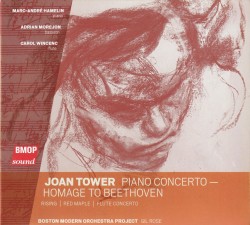 It seems Beethoven also provided inspiration to composer Joan Tower whose 1985 Piano Concerto – Homage to Beethoven is the title track on a new portrait CD from Gil Rose and the Boston Modern Orchestra Project (BMOP Sound 1093 bmop.org/audio-recordings). Soloist Marc-André Hamelin is in stellar form in the dramatic and often percussive work from 1985. Although there are no obvious quotations from Beethoven, Tower says “he had a huge influence on me in terms of how to try to create and motivate a strong dramatic structure.” She also says she included fragments from three Beethoven sonatas which are imbedded in the cadenzas. The most recent work is Red Maple, a bassoon concerto from 2013. Right from the extended solo opening, bassoonist Adrian Morejon establishes command, leading BMOP through the haunting quarter-hour virtuosic showpiece. There are two flute concertos bookending Red Maple, Rising for flute and string orchestra (2010, originally for flute and string quartet) and the 1989 Flute Concerto, both premiered by the outstanding Carol Wincenc who is the soloist here. This CD is a fitting tribute to Tower, the now 85-year-old American treasure whose successful career has spanned six decades.
It seems Beethoven also provided inspiration to composer Joan Tower whose 1985 Piano Concerto – Homage to Beethoven is the title track on a new portrait CD from Gil Rose and the Boston Modern Orchestra Project (BMOP Sound 1093 bmop.org/audio-recordings). Soloist Marc-André Hamelin is in stellar form in the dramatic and often percussive work from 1985. Although there are no obvious quotations from Beethoven, Tower says “he had a huge influence on me in terms of how to try to create and motivate a strong dramatic structure.” She also says she included fragments from three Beethoven sonatas which are imbedded in the cadenzas. The most recent work is Red Maple, a bassoon concerto from 2013. Right from the extended solo opening, bassoonist Adrian Morejon establishes command, leading BMOP through the haunting quarter-hour virtuosic showpiece. There are two flute concertos bookending Red Maple, Rising for flute and string orchestra (2010, originally for flute and string quartet) and the 1989 Flute Concerto, both premiered by the outstanding Carol Wincenc who is the soloist here. This CD is a fitting tribute to Tower, the now 85-year-old American treasure whose successful career has spanned six decades.
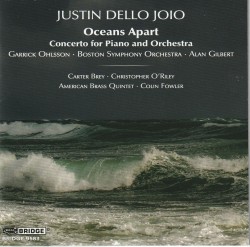 Joan Tower’s piano concerto put me in mind of one of my first exposures to modern (at the time contemporary) concertante works, more than half a century ago. I bought an LP of Ravel’s Piano Concerto in G featuring Lorin Hollander with the Boston Symphony Orchestra under Erich Leinsdorf that also included the premiere recording of Norman Dello Joio’s 1961 Fantasy and Variations for Piano and Orchestra. I fell in love with the Ravel, especially Hollander’s tender performance of the slow movement, but it was the Dello Joio that really caught my attention. Although that recording has recently been remastered, it is a piano concerto by his son Justin Dello Joio that I want to write about here. Oceans Apart: Concerto for Piano and Orchestra features Garrick Ohlsson with the Boston Symphony Orchestra under Alan Gilbert (Bridge Records 9583 bridgerecords.com). Composed in 2022, the title of the work refers, in part, to the “…the immensity, the oceanic vastness, of the polarization of our time. People seem to be moving irreparably apart. The waves of misinformation spreading relentlessly over the web, the belief that such a thing as ‘alternate facts’ can exist, and the swell of unharnessed power this has caused – these were in my thoughts.” Captured in a live performance, the work opens with “an unresolved tritone in the low register in the piano and the highest sounds, beyond any specific pitch, whispering incomprehensively and at the edge of audibility in the strings” which extends into a 20-minute dramatic contest between piano and orchestra. Ohlsson, for whom it was written, holds his own in a brilliant performance which, to paraphrase the composer, pits him like a surfer on a 100-foot wave against the daunting force of a large symphony orchestra. As the applause dies away we are treated to Due Per Due, two movements for cello and piano (Carter Brey and Christopher O’Riley), Elegia: To an Old Musician and Moto in Perpetuo. Written in 2011, three years after his father’s death, the first pays homage to Norman’s Prelude: To a Young Musician which Justin learned to play at the age of six. The second is as rambunctious and flamboyant as the title implies. This fine disc is completed by Blue and Gold Music written for the tricentennial of the Trinity School, in a sparkling performance by organist Colin Fowler and the American Brass Quintet.
Joan Tower’s piano concerto put me in mind of one of my first exposures to modern (at the time contemporary) concertante works, more than half a century ago. I bought an LP of Ravel’s Piano Concerto in G featuring Lorin Hollander with the Boston Symphony Orchestra under Erich Leinsdorf that also included the premiere recording of Norman Dello Joio’s 1961 Fantasy and Variations for Piano and Orchestra. I fell in love with the Ravel, especially Hollander’s tender performance of the slow movement, but it was the Dello Joio that really caught my attention. Although that recording has recently been remastered, it is a piano concerto by his son Justin Dello Joio that I want to write about here. Oceans Apart: Concerto for Piano and Orchestra features Garrick Ohlsson with the Boston Symphony Orchestra under Alan Gilbert (Bridge Records 9583 bridgerecords.com). Composed in 2022, the title of the work refers, in part, to the “…the immensity, the oceanic vastness, of the polarization of our time. People seem to be moving irreparably apart. The waves of misinformation spreading relentlessly over the web, the belief that such a thing as ‘alternate facts’ can exist, and the swell of unharnessed power this has caused – these were in my thoughts.” Captured in a live performance, the work opens with “an unresolved tritone in the low register in the piano and the highest sounds, beyond any specific pitch, whispering incomprehensively and at the edge of audibility in the strings” which extends into a 20-minute dramatic contest between piano and orchestra. Ohlsson, for whom it was written, holds his own in a brilliant performance which, to paraphrase the composer, pits him like a surfer on a 100-foot wave against the daunting force of a large symphony orchestra. As the applause dies away we are treated to Due Per Due, two movements for cello and piano (Carter Brey and Christopher O’Riley), Elegia: To an Old Musician and Moto in Perpetuo. Written in 2011, three years after his father’s death, the first pays homage to Norman’s Prelude: To a Young Musician which Justin learned to play at the age of six. The second is as rambunctious and flamboyant as the title implies. This fine disc is completed by Blue and Gold Music written for the tricentennial of the Trinity School, in a sparkling performance by organist Colin Fowler and the American Brass Quintet.
 My first exposure to the music of Claude Champagne (1891-1965) was an educational LP on the Canadian Music Enrichment label, one side of which was an uninterrupted performance of Symphonie Gaspésienne and on the other the same work with cues for a slideshow depicting the landscape of the Gaspé peninsula that inspired the work. Although not much attention was given to him in English Canada, where his contemporaries included Healy Willan and Sir Ernest MacMillan, Champagne was an important figure in the annals of classical music in Quebec, where his students included Violet Archer, Roger Matton, Pierre Mercure, Serge Garant and Gilles Tremblay among other notables. I was very pleased to see a new recording of Champagne’s brilliant tone poem featuring L’Orchestre symphonique de Laval under Alain Trudel (ATMA ACD2 4053 atmaclassique.com/en). Starting eerily in near silence, Trudel leads his orchestra through the gradually building portrait of the fabled peninsula with dramatic turns and climaxes along the 20-minute journey. Although the program notes mention Debussy and the Russian school as influences, I also hear echoes of Delius and Vaughan Williams in this marvelous one movement work. You can access the digital-only recording for free on the ATMA website.
My first exposure to the music of Claude Champagne (1891-1965) was an educational LP on the Canadian Music Enrichment label, one side of which was an uninterrupted performance of Symphonie Gaspésienne and on the other the same work with cues for a slideshow depicting the landscape of the Gaspé peninsula that inspired the work. Although not much attention was given to him in English Canada, where his contemporaries included Healy Willan and Sir Ernest MacMillan, Champagne was an important figure in the annals of classical music in Quebec, where his students included Violet Archer, Roger Matton, Pierre Mercure, Serge Garant and Gilles Tremblay among other notables. I was very pleased to see a new recording of Champagne’s brilliant tone poem featuring L’Orchestre symphonique de Laval under Alain Trudel (ATMA ACD2 4053 atmaclassique.com/en). Starting eerily in near silence, Trudel leads his orchestra through the gradually building portrait of the fabled peninsula with dramatic turns and climaxes along the 20-minute journey. Although the program notes mention Debussy and the Russian school as influences, I also hear echoes of Delius and Vaughan Williams in this marvelous one movement work. You can access the digital-only recording for free on the ATMA website.
Listen to 'Symphonie Gaspésienne' Now in the Listening Room
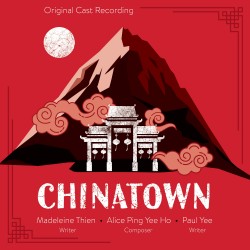 Chinatown (Leaf-Music LM281 leaf-music.ca) is a striking new opera featuring the words of Giller Prize laureate Madeleine Thien and music by multiple-award-winner Alice Ping Yee Ho. The project was initiated by City Opera Vancouver back in 2017 and developed over the next five years through a myriad of workshops and public consultations with Vancouver’s Chinese community. During that process the importance of the Hoisan language to the history of Vancouver’s Chinatown became evident as that was the province of China where many of the original immigrants came from. Writer Paul Yee was engaged to translate portions of the opera into the Hoisan dialect. The result is the first opera to depict a Canadian Chinatown, and the first libretto to combine Hoisanese, Cantonese and English. The orchestration features traditional Chinese and Western classical instruments. It tells the story of two families and a chorus of ghosts, beginning with the building of the Canadian Pacific Railroad through to our own times. It deals with “violence and despair, the Head Tax, the Exclusion Act, paper sons, and paper promises.” The opera was staged in 2022 under the direction of Mary Chun and this is the original cast recording of the groundbreaking milestone of the musical stage. The booklet includes a synopsis for each of the 12 scenes of the two-act opera, program notes and biographies in English, French and Chinese pictograms.
Chinatown (Leaf-Music LM281 leaf-music.ca) is a striking new opera featuring the words of Giller Prize laureate Madeleine Thien and music by multiple-award-winner Alice Ping Yee Ho. The project was initiated by City Opera Vancouver back in 2017 and developed over the next five years through a myriad of workshops and public consultations with Vancouver’s Chinese community. During that process the importance of the Hoisan language to the history of Vancouver’s Chinatown became evident as that was the province of China where many of the original immigrants came from. Writer Paul Yee was engaged to translate portions of the opera into the Hoisan dialect. The result is the first opera to depict a Canadian Chinatown, and the first libretto to combine Hoisanese, Cantonese and English. The orchestration features traditional Chinese and Western classical instruments. It tells the story of two families and a chorus of ghosts, beginning with the building of the Canadian Pacific Railroad through to our own times. It deals with “violence and despair, the Head Tax, the Exclusion Act, paper sons, and paper promises.” The opera was staged in 2022 under the direction of Mary Chun and this is the original cast recording of the groundbreaking milestone of the musical stage. The booklet includes a synopsis for each of the 12 scenes of the two-act opera, program notes and biographies in English, French and Chinese pictograms.
Listen to 'Chinatown' Now in the Listening Room
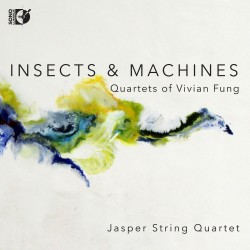 Edmonton-born, Juno Award-winning composer Vivian Fung first studied with Violet Archer, went on to receive her doctorate from the Juilliard School and is currently based in California. Insects & Machines – Quartets of Vivian Fung (Sono Luminus DSL-92270 sonoluminus.com) features the Jasper String Quartet – who have admired Fung since first performing one of her quartets in 2019 – being “immediately captivated by the visceral energy and impeccable craft of her writing.” The four works included span 18 years of her chamber output. Fung, whose family survived Cambodian genocide, has travelled extensively in the Far East and drew on folk music of certain parts of Asia, including China and Indonesia, for her String Quartet No.1. It began as a short movement written on assignment at the Atlantic Center for the Arts in 2001 for performance by the American String Quartet. The success of that reading inspired her to add three more movements, also drawing on Eastern themes, to complete the quartet in 2004. To my ear is it reminiscent of the “night music” style of Béla Bartók, especially in the original pizzicato movement. (What young composer would not be influenced by Bartók’s incredible contribution to the string quartet genre? And, having spoken of musical lineage earlier in this column, I will mention that Fung’s teacher Archer was herself a student of that Hungarian master.) Fung states that “issues of my Asian identity underscore much of my work.” String Quartet No.2 (2009), also uses a Chinese folksong for its base, and String Quartet No.3 (2013) evokes “a non-Western song […] highly ornamented, powerful, and tuned to suggest the microtonal tendencies found in many non-Western scales.” String Quartet No.4: Insects & Machines is likewise inspired by travels to the Orient, this time Cambodia, where “I was especially attuned to the persistent noises of buzzing insects that accompanied my walk through the thick jungle.” The subtitle aptly describes the divisions of this one-movement work: Buzzing… whirring… glitching… ringing… thumping…. The members of the Jasper String Quartet – named after Canada’s Jasper National Park, although I cannot find another Canadian connection to the group – rise to the multiple challenges posed by Fung throughout these works, but especially in the unrelenting and virtuosic tour de force of this final quartet. But final is not the right word: Fung has recently completed a fifth for Victoria’s Lafayette String Quartet.
Edmonton-born, Juno Award-winning composer Vivian Fung first studied with Violet Archer, went on to receive her doctorate from the Juilliard School and is currently based in California. Insects & Machines – Quartets of Vivian Fung (Sono Luminus DSL-92270 sonoluminus.com) features the Jasper String Quartet – who have admired Fung since first performing one of her quartets in 2019 – being “immediately captivated by the visceral energy and impeccable craft of her writing.” The four works included span 18 years of her chamber output. Fung, whose family survived Cambodian genocide, has travelled extensively in the Far East and drew on folk music of certain parts of Asia, including China and Indonesia, for her String Quartet No.1. It began as a short movement written on assignment at the Atlantic Center for the Arts in 2001 for performance by the American String Quartet. The success of that reading inspired her to add three more movements, also drawing on Eastern themes, to complete the quartet in 2004. To my ear is it reminiscent of the “night music” style of Béla Bartók, especially in the original pizzicato movement. (What young composer would not be influenced by Bartók’s incredible contribution to the string quartet genre? And, having spoken of musical lineage earlier in this column, I will mention that Fung’s teacher Archer was herself a student of that Hungarian master.) Fung states that “issues of my Asian identity underscore much of my work.” String Quartet No.2 (2009), also uses a Chinese folksong for its base, and String Quartet No.3 (2013) evokes “a non-Western song […] highly ornamented, powerful, and tuned to suggest the microtonal tendencies found in many non-Western scales.” String Quartet No.4: Insects & Machines is likewise inspired by travels to the Orient, this time Cambodia, where “I was especially attuned to the persistent noises of buzzing insects that accompanied my walk through the thick jungle.” The subtitle aptly describes the divisions of this one-movement work: Buzzing… whirring… glitching… ringing… thumping…. The members of the Jasper String Quartet – named after Canada’s Jasper National Park, although I cannot find another Canadian connection to the group – rise to the multiple challenges posed by Fung throughout these works, but especially in the unrelenting and virtuosic tour de force of this final quartet. But final is not the right word: Fung has recently completed a fifth for Victoria’s Lafayette String Quartet.
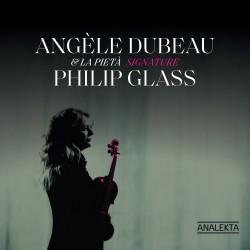 Speaking of string quartets, later on in these pages you will find Terry Robbins’ take on Quatuor Molinari’s latest installment of the quartets of Philip Glass. The Molinari is not the only Montreal-based ensemble to have an ongoing interest in the American minimalist master, and Angèle Dubeau & La Pietà have just released a follow-up to their 2008 Philip Glass: Portrait album. Signature: Philip Glass (Analekta AN 2 8755 outhere-music.com/en/labels/analekta) is comprised of 16 short movements drawn from a dozen “signature” works spanning most of four decades. Dubeau says that for many years she has found Glass’ music “nourishing intellectually and musically” and for this, her 48th album, she chose works she finds “significant and compelling” from his vast oeuvre. Opening (appropriately) with Opening from 1981’s Glassworks, the earliest work on the disc, we journey through the years with stops at such classics as Symphony No.3, Koyaanisqatsi, The Somnambulist, A Brief History of Time, Candyman Suite and several movements from Bent. New to me, and of particular interest, is the extended movement from the 2018 Piano Quintet and two Duos for Violin and Cello from 2010 (featuring Dubeau and Julie Trudeau). The arrangements and adaptations are by Dubeau and François Vallières and they are compelling indeed.
Speaking of string quartets, later on in these pages you will find Terry Robbins’ take on Quatuor Molinari’s latest installment of the quartets of Philip Glass. The Molinari is not the only Montreal-based ensemble to have an ongoing interest in the American minimalist master, and Angèle Dubeau & La Pietà have just released a follow-up to their 2008 Philip Glass: Portrait album. Signature: Philip Glass (Analekta AN 2 8755 outhere-music.com/en/labels/analekta) is comprised of 16 short movements drawn from a dozen “signature” works spanning most of four decades. Dubeau says that for many years she has found Glass’ music “nourishing intellectually and musically” and for this, her 48th album, she chose works she finds “significant and compelling” from his vast oeuvre. Opening (appropriately) with Opening from 1981’s Glassworks, the earliest work on the disc, we journey through the years with stops at such classics as Symphony No.3, Koyaanisqatsi, The Somnambulist, A Brief History of Time, Candyman Suite and several movements from Bent. New to me, and of particular interest, is the extended movement from the 2018 Piano Quintet and two Duos for Violin and Cello from 2010 (featuring Dubeau and Julie Trudeau). The arrangements and adaptations are by Dubeau and François Vallières and they are compelling indeed.
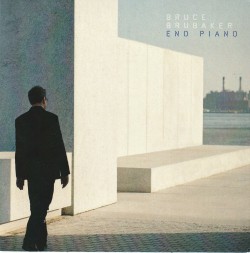 Around the same time that I was discovering the music of Philip Glass in the late 1970s I was also intrigued by the ambient compositions of Brian Eno such as Music for Airports. Glass had a seminal influence on Eno who, in 1971 along with David Bowie, heard Glass perform at the Royal College of Art in London. Glass would later acknowledge a reciprocal influence, composing three symphonies based on Eno and Bowie’s Berlin Trilogy of albums. In 2015 Bruce Brubaker released Glass Piano and with his latest, Eno Piano (infiné iF1088 infine-music.com) the connections continue. Whereas Eno used a variety of techniques and tape loops to create the drones and sustained notes of his ambient creations, in effect making the studio his instrument, with aid of new technologies such as the EBow (an electromagnetic device used to make long notes on the strings of a guitar or piano) and the latest spatialization techniques from IRCAM, Brubaker has effectively turned the grand piano into a studio to be played in real time. It’s quite a stunning achievement. The tracks on offer are the three parts of Music for Airports along with three shorter works, The Chill Air (from Ambient 2 with Harold Budd, 1980), By This River (Before and After Science, 1977) and Emerald and Stone (Small Craft on a Milk Sea, 2010).
Around the same time that I was discovering the music of Philip Glass in the late 1970s I was also intrigued by the ambient compositions of Brian Eno such as Music for Airports. Glass had a seminal influence on Eno who, in 1971 along with David Bowie, heard Glass perform at the Royal College of Art in London. Glass would later acknowledge a reciprocal influence, composing three symphonies based on Eno and Bowie’s Berlin Trilogy of albums. In 2015 Bruce Brubaker released Glass Piano and with his latest, Eno Piano (infiné iF1088 infine-music.com) the connections continue. Whereas Eno used a variety of techniques and tape loops to create the drones and sustained notes of his ambient creations, in effect making the studio his instrument, with aid of new technologies such as the EBow (an electromagnetic device used to make long notes on the strings of a guitar or piano) and the latest spatialization techniques from IRCAM, Brubaker has effectively turned the grand piano into a studio to be played in real time. It’s quite a stunning achievement. The tracks on offer are the three parts of Music for Airports along with three shorter works, The Chill Air (from Ambient 2 with Harold Budd, 1980), By This River (Before and After Science, 1977) and Emerald and Stone (Small Craft on a Milk Sea, 2010).
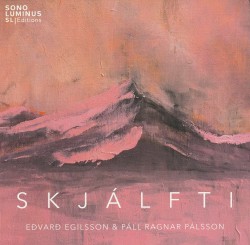 Another contemporary take on the ambient genre, Skjálfti (Quake) by composers Páll Ragnar Pálsson and Eðvarð Egilsson (sonoluminus-com/store/skjalf) extrapolates a 15-part suite from their soundtrack to the 2021 Icelandic film of the same name. Written and directed by Tinna Hrafnsdóttir, the film tells the story of Saga, an author and mother who, after an epileptic seizure, experiences memory loss at the same time as hidden memories of family secrets begin to resurface. The psychological drama the film explores is hauntingly realized in this effective expansion of the original soundtrack that comprised 40 very brief segments, developing them into a strikingly atmospheric stand-alone work.
Another contemporary take on the ambient genre, Skjálfti (Quake) by composers Páll Ragnar Pálsson and Eðvarð Egilsson (sonoluminus-com/store/skjalf) extrapolates a 15-part suite from their soundtrack to the 2021 Icelandic film of the same name. Written and directed by Tinna Hrafnsdóttir, the film tells the story of Saga, an author and mother who, after an epileptic seizure, experiences memory loss at the same time as hidden memories of family secrets begin to resurface. The psychological drama the film explores is hauntingly realized in this effective expansion of the original soundtrack that comprised 40 very brief segments, developing them into a strikingly atmospheric stand-alone work.
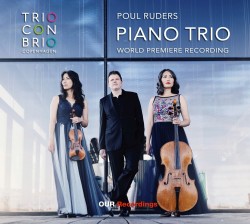 Having begun this column with Beethoven’s impressive cycle of piano trios, I will close with the world premiere recording of one of the latest contributions to that time-honoured genre. Renowned Danish composer Poul Ruders (b.1949) had written some two dozen orchestral works (including five symphonies), as many concertante works, and countless chamber pieces (including four string quartets), before embarking on his first Piano Trio in 2020. Written for the Trio Con Brio Copenhagen, featured here in a performance that lives up to the group’s name, the composer describes it as a Kantian “thing in itself” with no hidden agenda. As per the accompanying press release, “The outer movements zip by in a flurry of heightened virtuosity that verges on the ecstatic (or hysterical, depending on your mood).” The contemplative central movement, Slow Motion, provides some much-needed respite from the at times abrasive opening, and a chance to catch your breath before the whirlwind finale. This is a fine example of how older forms can serve contemporary purposes. Cudos to all involved in this exceptional project (Our Recordings 9.70892 ourrecordings.com).
Having begun this column with Beethoven’s impressive cycle of piano trios, I will close with the world premiere recording of one of the latest contributions to that time-honoured genre. Renowned Danish composer Poul Ruders (b.1949) had written some two dozen orchestral works (including five symphonies), as many concertante works, and countless chamber pieces (including four string quartets), before embarking on his first Piano Trio in 2020. Written for the Trio Con Brio Copenhagen, featured here in a performance that lives up to the group’s name, the composer describes it as a Kantian “thing in itself” with no hidden agenda. As per the accompanying press release, “The outer movements zip by in a flurry of heightened virtuosity that verges on the ecstatic (or hysterical, depending on your mood).” The contemplative central movement, Slow Motion, provides some much-needed respite from the at times abrasive opening, and a chance to catch your breath before the whirlwind finale. This is a fine example of how older forms can serve contemporary purposes. Cudos to all involved in this exceptional project (Our Recordings 9.70892 ourrecordings.com).
Listen to 'Piano Trio' Now in the Listening Room
We invite submissions. CDs, DVDs and comments should be sent to: DISCoveries, The WholeNote c/o Music Alive, The Centre for Social Innovation, 720 Bathurst St. Toronto ON M5S 2R4 or to discoveries@thewholenote.com.


